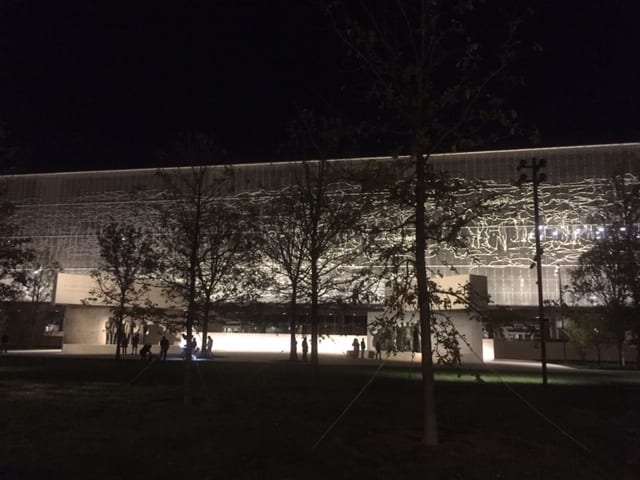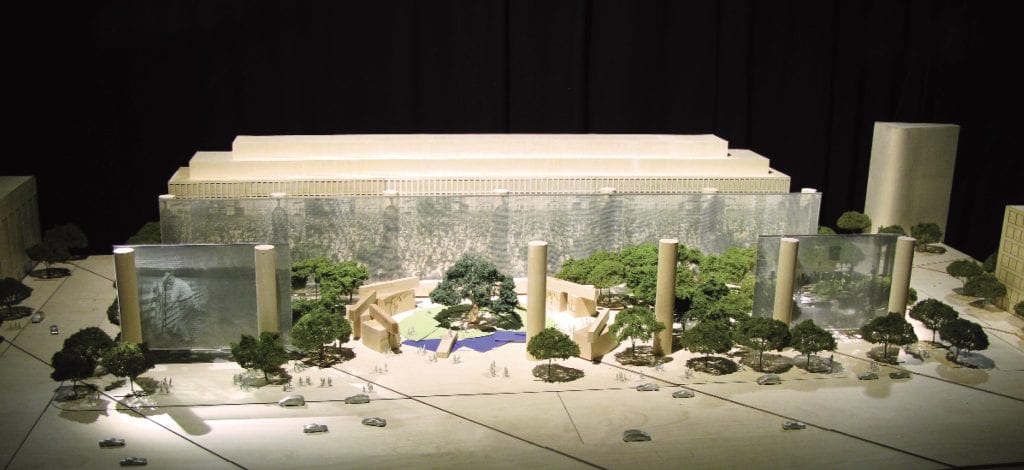A Tribute to Eisenhower
Night view of the memorial tapestry from Independence Avenue, with Gehry’s sketch of the Normandy cliffs.
Explaining the contributions of a World War II hero and later President of the United States on a very modest site on Independence Avenue just off the Washington Mall is tantamount to asking an author to describe the life of this person in no more than one paragraph. But on September 17th, after a long and bumpy journey, lasting almost 20 years and navigating a warren of the DC approval processes and public scrutiny, the Eisenhower Memorial finally was dedicated and opened to the public. Designed by Frank Gehry, it has received mixed reviews, the majority being more positive. But most have pointed out that the memorial is more impressive at night than in full daylight. This is due primarily to the illumination of an almost block-long metallic tapestry—featuring a sketch by Gehry, which depicts his interpretation of the cliffs of the Normandy coastline where the Americans landed on D-Day. The Competition
In 2008, the groundwork was laid for the staging of a design competition. Although one of the Commission members suggested that Frank Gehry be given the commission outright to furnish a design, cooler heads prevailed, and an invited competition* with a shortlisting process resulted in entries from four finalists:
• Gehry Partners, Santa Monica, California
• Rogers Marvel Architects PLLC, New York, NY
• Krueck & Sexton, Chicago, Illinois
• PWP Landscape Architects, Berkeley, California
Contrary to the other presenters, Gehry arrived with three proposals, not just one. This was not regarded by the jury as a rules violation, and the commission to execute the design of the memorial went to Gehry. Gehry’s original proposal, as seen during a development phase after winning the competition, featured six columns bordering on Independence Avenue. It did recognize the difficulty of this rather cramped site to make such an important statement. Thus, the approach became an open area, leaving the tapestry as a backdrop to the blocks providing information about Eisenhower’s life. The only remaining columns openly visible from Independence Avenue were one at each end of the site. 
 Early 2010 development design after the close of the competition. Photos: courtesy ©Gehry Partners Dropping the idea of the majority of those columns on Independence Avenue actually became rather unimportant, as the others are now partially hidden and vaguely visible as part of the tapestry. The final use of columns, although having no support function, was on the rear side of the tapestry, facing the 1961 Department of Education building.** The relatively narrow space between the memorial and the Department of Education building was treated rather mundanely, with almost no vegetation to soften the impact of lots of stone.
But the more important features of this memorial, information-wise, were the inscriptions placed throughout the site, briefs narratives about Ike’s life, and the impressive visual interpretations of Eisenhower by sculptor, Sergey Eylanbekov. Conclusion
Capturing the multifaceted career of Dwight Eisenhower, from army general to university president and U.S. president, is no easy task. You might say he was an administrator at different levels; with his strengths and weaknesses in all of those pursuits. What he also can be remembered for is his talent for delegating tasks to experts with real expertise in the decision-making processes, a talent so lacking in our present day administration. Gehry may only have managed to suggest this on the surface: a total image reflecting such a talent cannot be easily projected solely with the landing in Normandy. But one certain strength of this memorial is its 24-hour access, where visitors can read about Ike’s most important accomplishments during an important period in our history. *Here it should be noted that Ed Feiner, head of the GSA’s Excellence in Architecture program, was a strong voice for an open competition, similar to that which resulted in the Vietnam Memorial. An article on the design competition was published in COMPETITIONS, Vol. 20, #4 (2010). See:
**This use of columns was reportedly a concession made by Gehry to obtain approval from Commission member, David Eisenhower. 




 

Current photos: ©Paul Spreiregen To access the original COMPETITIONS article about the competition, go to:
https://competitions.org/2011/02/new-article/?preview_id=17063&preview_nonce=269fd837f9&_thumbnail_id=17062&preview=true |

1st Place: Zaha Hadid Architects – night view from river – Render by Negativ
Arriving to board a ferry boat or cruise ship used to be a rather mundane experience. If you had luggage, you might be able to drop it off upon boarding, assuming that the boarding operation was sophisticated enough. In any case, the arrival experience was nothing to look forward to. I recall boarding the SS United States for a trip to Europe in the late 1950s. Arriving at the pier in New York, the only thought any traveler had was to board that ocean liner as soon as possible, find one’s cabin, and start exploring. If you were in New York City and arriving early, a nearby restaurant or cafe would be your best bet while passing time before boarding. Read more… Young Architects in Competitions When Competitions and a New Generation of Ideas Elevate Architectural Quality 
by Jean-Pierre Chupin and G. Stanley Collyer
published by Potential Architecture Books, Montreal, Canada 2020
271 illustrations in color and black & white
Available in PDF and eBook formats
ISBN 9781988962047
Wwhat do the Vietnam Memorial, the St. Louis Arch, and the Sydney Opera House have in common? These world renowned landmarks were all designed by architects under the age of 40, and in each case they were selected through open competitions. At their best, design competitions can provide a singular opportunity for young and unknown architects to make their mark on the built environment and launch productive, fruitful careers. But what happens when design competitions are engineered to favor the established and experienced practitioners from the very outset? This comprehensive new book written by Jean-Pierre Chupin (Canadian Competitions Catalogue) and Stanley Collyer (COMPETITIONS) highlights for the crucial role competitions have played in fostering the careers of young architects, and makes an argument against the trend of invited competitions and RFQs. The authors take an in-depth look at past competitions won by young architects and planners, and survey the state of competitions through the world on a region by region basis. The end result is a compelling argument for an inclusive approach to conducting international design competitions. Download Young Architects in Competitions for free at the following link: https://crc.umontreal.ca/en/publications-libre-acces/ 
Helsinki Central Library, by ALA Architects (2012-2018)
The world has experienced a limited number of open competitions over the past three decades, but even with diminishing numbers, some stand out among projects in their categories that can’t be ignored for the high quality and degree of creativity they revealed. Included among those are several invited competitions that were extraordinary in their efforts to explore new avenues of institutional and museum design. Some might ask why the Vietnam Memorial is not mentioned here. Only included in our list are competitions that were covered by us, beginning in 1990 with COMPETITIONS magazine to the present day. As for what category a project under construction (Science Island), might belong to or fundraising still in progress (San Jose’s Urban Confluence or the Cold War Memorial competition, Wisconsin), we would classify the former as “built” and wait and see what happens with the latter—keeping our fingers crossed for a positive outcome. Read More… 
2023 Teaching and Innovation Farm Lab Graduate Student Honor Award by USC (aerial view)
Architecture at Zero competitions, which focus on the theme, Design Competition for Decarbonization, Equity and Resilience in California, have been supported by numerous California utilities such as Southern California Edison, PG&E, SoCAl Gas, etc., who have recognized the need for better climate solutions in that state as well as globally. Until recently, most of these competitions were based on an ideas only format, with few expectations that any of the winning designs would actually be realized. The anticipated realization of the 2022 and 2023 competitions suggests that some clients are taking these ideas seriously enough to go ahead with realization. Read more… 
RUR model perspective – ©RUR
New Kaohsiung Port and Cruise Terminal, Taiwan (2011-2020)
Reiser+Umemoto RUR Architecture PC/ Jesse Reiser – U.S.A.
with
Fei & Cheng Associates/Philip T.C. Fei – R.O.C. (Tendener)
This was probably the last international open competition result that was built in Taiwan. A later competition for the Keelung Harbor Service Building Competition, won by Neil Denari of the U.S., the result of a shortlisting procedure, was not built. The fact that the project by RUR was eventually completed—the result of the RUR/Fei & Cheng’s winning entry there—certainly goes back to the collaborative role of those to firms in winning the 2008 Taipei Pop Music Center competition, a collaboration that should not be underestimated in setting the stage for this competition Read more… 
Winning entry ©Herzog de Meuron
In visiting any museum, one might wonder what important works of art are out of view in storage, possibly not considered high profile enough to see the light of day? In Korea, an answer to this question is in the making. It can come as no surprise that museums are running out of storage space. This is not just the case with long established “western” museums, but elsewhere throughout the world as well. In Seoul, South Korea, such an issue has been addressed by planning for a new kind of storage facility, the Seouipul Open Storage Museum. The new institution will house artworks and artifacts of three major museums in Seoul: the Seoul Museum of Modern Art, the Seoul Museum of History, and the Seoul Museum of Craft Art.
Read more… |












































